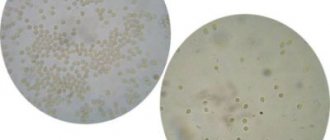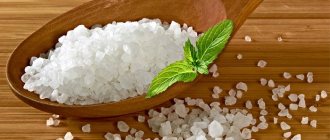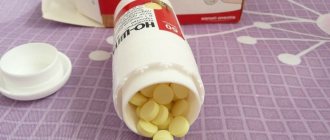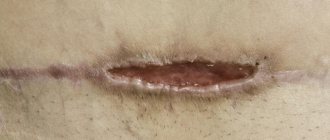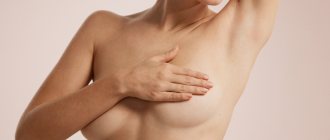Causes of hyposthenuria
Physiological reasons
During the day, the relative density of urine of a healthy person fluctuates widely - from 1003 to 1030 g/ml.
This indicator depends on many factors, for example, with excess fluid consumption, the specific gravity may decrease for a short time. The kidneys of newborn children are not able to concentrate urine, so they experience hyposthenuria (about 1002 g/ml). Treatment of edema syndrome with diuretics can also be considered physiological hyposthenuria, since the relative density is inversely proportional to the volume of urine excreted. During the period of swelling, under the influence of diuretics, diuresis increases and “urine dilution” occurs.
Kidney diseases
The most common cause of hyposthenuria is kidney pathology. To maintain ionic balance in the blood and other tissues of the body during urine formation, the kidney tubules excrete various electrolytes (sodium, potassium, calcium, chlorides, bicarbonates, etc.) into the urine. This is called "renal concentrating function." If the tubules are damaged, this ability is impaired.
Since tubular damage to one degree or another is observed in almost every renal disease, they are quite often accompanied by hyposthenuria. Its severity directly correlates with the severity of nephrological pathology. Specific treatment leads to a gradual normalization of specific gravity. The most common kidney diseases in which hyposthenuria occurs:
- glomerulonephritis;
- pyelonephritis;
- hypertensive nephropathy;
- tubular dysfunctions (tubulointerstitial nephritis, renal tubular acidosis);
- chronic renal failure.
Hyposthenuria
Diabetes insipidus
Vasopressin (antidiuretic hormone) is the main regulator of water balance in the body. With diabetes insipidus, its absolute (in the central form) or relative (in the nephrogenic form) deficiency occurs, which causes severe polyuria (up to 15-20 liters per day) and hyposthenuria due to urine dilution.
Replacement therapy for central diabetes insipidus quickly leads to an increase in relative density to normal values. The nephrogenic form, due to the resistance of the renal tubules to antidiuretic hormone, is much more difficult to treat, so hyposthenuria can persist for a long time.
Causes of central NSD:
- brain injuries;
- surgical interventions on the central nervous system;
- brain tumors;
- previous meningitis or encephalitis.
Causes of nephrogenic NSD:
- vasopressin receptor mutations;
- various kidney pathologies;
- electrolyte disturbances (hypercalcemia, hypokalemia).
What urine test result is considered bad in adults?
If there is a deviation from the norm in the urine test, a doctor will help you figure it out.
The main abnormalities in a general urine test are:
- the appearance of any amount of protein;
- the presence of more than 2-3 red blood cells;
- an increase in the amount of sugar and ketone bodies above the permissible norm;
- excess volume of urea, uric acid, creatinine;
- the appearance of any amount of bilirubin, hemoglobin;
- the presence of any amount of salts, bacteria, parasites, fungi;
- change in physical parameters (turbidity, sedimentation, foam on the surface, unpleasant odor, increase in density).
Urine analysis in women and men differs in the number of constituent elements.
Color
The color of urine should be bright yellow, without impurities or turbidity. In the normal state of the body, the color of urine in the morning is darker. During the day it brightens as a person drinks liquid.
If the patient consumes foods with a large amount of coloring substances, the shade of the biological fluid changes. For example, when eating beets, he turns red.
Transparency
The inside of the urinary tract should not contain bacteria, salts, fungi, or parasites. In the presence of a pathological process, the biological fluid becomes cloudy and a heavy sediment forms.
Urine should be completely transparent; sediment will form only when the sample sits for a long time.
Acidity
The acid-base balance of a normal sample ranges from 5 to 7 units. Such values are necessary to combat pathogenic microorganisms that die under the influence of acids.
Changes in the acidity level are acceptable. If they are severely disturbed, this may mean a violation of water-electrolyte metabolism, metabolism, and endocrine diseases.
Concentration
Urine concentration is an indicator that determines the concentration ability of the kidneys. That is, the volume of substances that they pass through the filtration barrier. Otherwise, the indicator is called urine density.
A decrease in density occurs with renal failure. An increase in concentration indicates diabetes mellitus.
Protein in urine
There should be no protein in the urine. If it appears, inflammatory diseases of the kidneys and a decrease in their function are possible. Only minor traces of protein are detected. They occur rarely. For example, after antibiotic therapy or an infectious disease.

Diagnostics
Despite the fact that this condition may have physiological causes, if hyposthenuria is detected, you should immediately consult a general practitioner or nephrologist to determine the etiological factor. At the appointment, the doctor asks the patient about complaints that may be useful in the differential diagnosis, such as the urge to urinate at night (nocturia), which is characteristic of kidney disease, or a constant feeling of thirst, typical of patients with untreated diabetes insipidus.
During examination, attention is paid to the presence of edema on the face or lower extremities. During the physical examination, blood pressure is measured and Pasternatsky's sign is checked. It is worth noting that when determining relative density during clinical urine analysis, test strips are used.
The reagent zone of the strip changes its sensitivity depending on the pH of the environment, therefore, if the urine is alkaline, a false underestimation of specific gravity readings is possible. The following studies are also prescribed:
- Blood tests.
In a biochemical blood test, an increase in the concentration of urea, creatinine, and C-reactive protein may be noted. In people suffering from diabetes insipidus, hypernatremia and an increase in plasma osmolarity are detected. - Urine tests.
Other indicators of general urine analysis, such as hematuria, proteinuria, leukocyturia, can help in the diagnostic search for the etiological factor. In people with diabetes insipidus, urine sodium concentration and osmolarity are reduced. - Hormonal studies.
Determination of the content of antidiuretic hormone is carried out for the differential diagnosis of forms of diabetes insipidus. With central NSD, the hormone concentration is reduced, while with nephrogenic one, it is normal or even increased. - Ultrasound of the kidneys.
In nephrological diseases, various pathological signs are detected - expansion of the pyelocaliceal system, changes in the parenchyma, reduction in size (“shrinking”) of the organ.
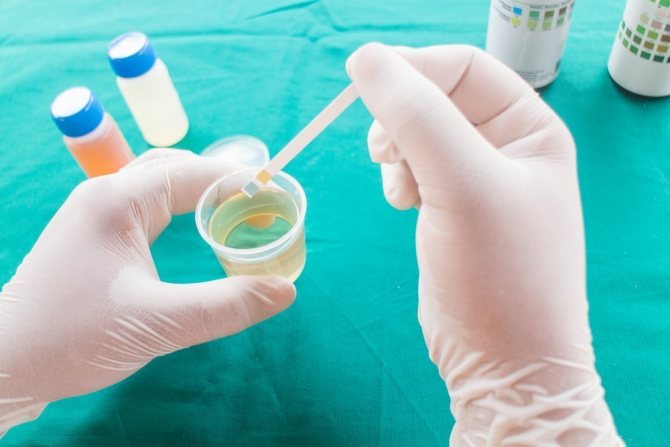
Diagnosis of hyposthenuria
What urine test result is considered bad in adults?
If there is a deviation from the norm in the urine test, a doctor will help you figure it out.
The main abnormalities in a general urine test are:
- the appearance of any amount of protein;
- the presence of more than 2-3 red blood cells;
- an increase in the amount of sugar and ketone bodies above the permissible norm;
- excess volume of urea, uric acid, creatinine;
- the appearance of any amount of bilirubin, hemoglobin;
- the presence of any amount of salts, bacteria, parasites, fungi;
- change in physical parameters (turbidity, sedimentation, foam on the surface, unpleasant odor, increase in density).
Urine analysis in women and men differs in the number of constituent elements.
The color of urine should be bright yellow, without impurities or turbidity. In the normal state of the body, the color of urine in the morning is darker. During the day it brightens as a person drinks liquid.
If the patient consumes foods with a large amount of coloring substances, the shade of the biological fluid changes. For example, when eating beets, he turns red.
Transparency
The inside of the urinary tract should not contain bacteria, salts, fungi, or parasites. In the presence of a pathological process, the biological fluid becomes cloudy and a heavy sediment forms.
Urine should be completely transparent; sediment will form only when the sample sits for a long time.
Acidity
The acid-base balance of a normal sample ranges from 5 to 7 units. Such values are necessary to combat pathogenic microorganisms that die under the influence of acids.
Changes in the acidity level are acceptable. If they are severely disturbed, this may mean a violation of water-electrolyte metabolism, metabolism, and endocrine diseases.
Concentration
Urine concentration is an indicator that determines the concentration ability of the kidneys. That is, the volume of substances that they pass through the filtration barrier. Otherwise, the indicator is called urine density.
A decrease in density occurs with renal failure. An increase in concentration indicates diabetes mellitus.
Protein in urine
There should be no protein in the urine. If it appears, inflammatory diseases of the kidneys and a decrease in their function are possible. Only minor traces of protein are detected. They occur rarely. For example, after antibiotic therapy or an infectious disease.
Correction
There are no independent methods for correcting hyposthenuria. To eliminate it, treatment of the underlying disease is necessary. The following medications are used as conservative therapy:
- Antibiotics.
Patients with pyelonephritis are prescribed antibacterial agents from the group of penicillins (amoxicillin) or cephalosporins (cefexime). - Glucocorticoids.
To stop the inflammatory process in the renal tissue during glomerulonephritis, glucocorticosteroids (prednisolone, methylprednisolone) are used. - Cytostatics.
In severe and rapidly progressive forms of glomerulonephritis, in case of ineffectiveness of glucocorticoids, cytostatics (azathioprine, cyclophosphamide) are added to treatment. - Desmopressin
. This drug is a synthetic analogue of antidiuretic hormone. In tablet or intranasal form, it is used as hormone replacement therapy for the treatment of central diabetes insipidus. - NSAIDs.
Prescribed for nephrogenic NSD. Nonsteroidal anti-inflammatory drugs (indomethacin, ibuprofen) can reduce the formation of prostaglandins in the kidneys, which several times increases the sensitivity of the kidney tubules to vasopressin. - Diuretics.
Thiazide diuretics, when taken for a long time, reduce the excretion of water in the urine. Due to this property, they are successfully used in patients with NSD. To enhance the implementation of this effect, the patient should limit the consumption of table salt.
Risk factors for urinary retention
It will not be possible to get rid of urinary retention on your own, because this pathology may well be accompanied by a more serious disorder in the body. Only an experienced urologist will be able to understand the causes of the disease and prescribe treatment taking into account the patient’s individual characteristics.
The main signs of urinary retention include:
- injury to the genital organ;
- complications after operations with surgical intervention;
- interruptions in the functioning of the nervous system;
- infectious diseases;
- formation of stones in the kidneys or bladder;
- advanced age;
- taking excessive amounts of medications;
- poor quality food.
If an acute condition suddenly occurs, it is necessary to urgently call a urologist at home. The doctor will arrive shortly and provide first emergency care, followed by recommendations for care and possible hospitalization.
Common symptoms and manipulations in urology:
- Pain when urinating
- Discharge from the urethra
- Itching in the urethra
- Short frenulum of the foreskin
- Prostate massage
- Prevention of casual sex
- Frenum plastic surgery
- Circumcision
- Kidney pain
- Perineal pain
- Stones in the kidneys
- Pus in urine
- Catheter removal at home
- Bougienage of the urethra
- Urinary retention
- Urological examination
- Papillomas on the foreskin
- erectile disfunction
- Make an appointment with a urologist
